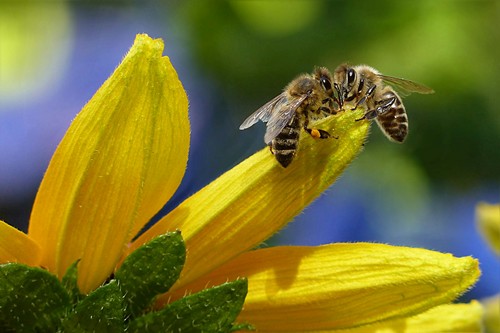Honey bees are essential for productive agriculture and the environment.
Bees play a vital role in agriculture as natural pollinators. Pollination is a necessary part of some plants’ fertilization processes, because it allows for the development of fruits and seeds.
One-third of the food you eat depends upon pollination, including almonds, apples, berries, cucumbers and melons. Bees have an important role in contributing a service that helps provide us with variety and more nutritious food.
“Honey bee pollination supports an estimated $15 billion worth of agricultural production, including more than 130 fruits and vegetables that are the foundation of a nutritious diet,” Agriculture Secretary Tom Vilsack said in a USDA press release dated February 2014.
Farmers are facing the challenge of providing more food for a growing population. And, the honey bee population has been facing its own problems.
Honey Bees have been here since the early 1600’s, brought over by the colonists. The health and well-being of honey bees on a national level has seemed dire since late 2006, when beekeepers began reporting losses of 30-90 percent of their hives, according to the U.S. Department of Agriculture (USDA). The bees weren’t dead, they were just gone without a trace—leaving behind a puzzle that has a label, but no easy answers.
You can help, there are a number of things that you can do in your own landscape this spring to help challenged bees.
- Include early blooming trees and shrubs in your landscape for bee species that emerge early in the spring. Maples are a particularly valuable source of early pollen and nectar. Even our common Pussy Willow is a critical early pollen source.
- Emphasize regionally native plants in your landscape that have evolved with our native bee species. Honey bees are “forage generalists” and can utilize many of our flowering native plants.
- Plant for a succession of bloom from early spring through late fall to provide nectar and pollen to different bee species which are active at different times of year.
- Plant a diversity of native plants with varied flower shapes and sizes. Plants with long, tubular flowers, such as Larkspur, can be accessed by long-tongued bees. Bees with shorter tongues, like honey bees, need plants that are easier to access, such as Asters.
- Give bees a floral target by planting a mass of the same plant for them to find. Aim for a 4 foot x 4 foot expanse, if possible. Meadows or mini meadows, with a repetition of flowers, will also work well for bees.
- You can provide bees with habitat as well as forage. While Honey Bees live in large colonies, native bees live in very small colonies or are solitary. 70 percent of our native bees nest in the ground and need a sunny area with bare soil or very little vegetation.
- Bees are highly sensitive to pesticides. Skip the secret sauce in your landscape.
By creating a bee-friendly landscape you will have the bonus of attracting butterflies and improving the overall ecological health of your property. And, you will enjoy the beautiful landscape you have created.
The use of Locally grown produce and honey that has a local pollination is far better for you than what is purchased in the supermarket. Visit your local farmers market and stop at the place where you see the homemade honey for sale sign. The health benefits of local will simply amaze you!
Sources: Norwalk Daily Voice, Monsanto



